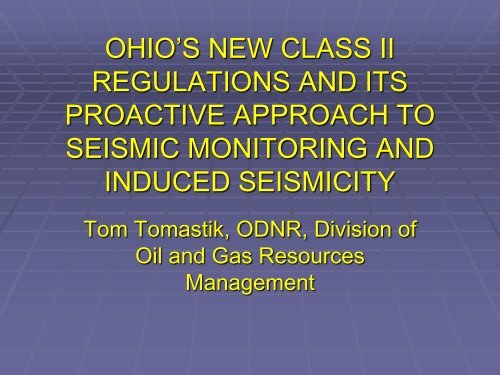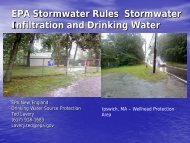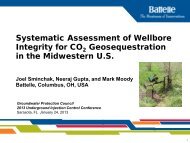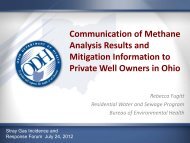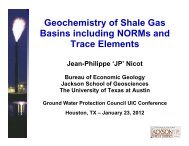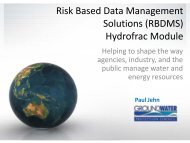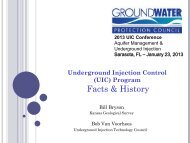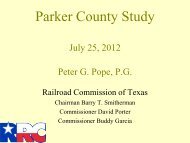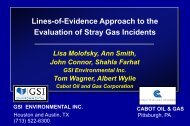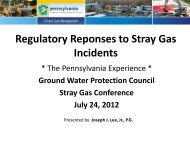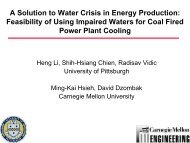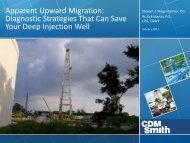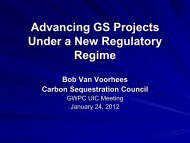Tom Tomastik
Tom Tomastik
Tom Tomastik
Create successful ePaper yourself
Turn your PDF publications into a flip-book with our unique Google optimized e-Paper software.
OHIO’S NEW CLASS II<br />
REGULATIONS AND ITS<br />
PROACTIVE APPROACH TO<br />
SEISMIC MONITORING AND<br />
INDUCED SEISMICITY<br />
<strong>Tom</strong> <strong>Tom</strong>astik, ODNR, Division of<br />
Oil and Gas Resources<br />
Management
THE YOUNGSTOWN EVENT<br />
• On December 31,2011 a 4.0<br />
magnitude seismic event<br />
occurred near the Class II<br />
Northstar #1 injection well in<br />
Youngstown, Ohio<br />
• Caused immediate changes to<br />
the Class II saltwater injection<br />
well program<br />
• Shutdown three other Class II<br />
wells and one Class II permit<br />
in a seven mile radius around<br />
the Northstar #1<br />
• Put a hold on the issuance of<br />
any new permits<br />
• A preliminary report on the<br />
Youngstown seismic events<br />
was released in March of 2012
THE AFTERMATH<br />
• Due to these seismic events, the Director of<br />
Ohio DNR and the Governor initiated drafting of<br />
new regulations to help prevent larger<br />
magnitude induced seismicity associated with<br />
Class II injection<br />
• Regulations to be based upon sound scientific<br />
methods<br />
• Development of regulations that are evaluated<br />
and implemented on a well-by-well basis
DRAFT REGULATIONS<br />
• The drafting of new Class II SWD regulations<br />
started in late spring of 2012<br />
• On July 10, 2012, the Governor issued<br />
Executive Order 2012-09K as an emergency<br />
amendment of UIC Rules 1501:9-3-06 and<br />
1501:9-3-07 of the Ohio Administrative Code<br />
• This Executive Order allowed for the<br />
implementation of new draft UIC rules into the<br />
legislative process.
NEW CLASS II REGULATIONS<br />
• The new UIC Class II saltwater injection well rules<br />
proceeded through the legislative process, were passed<br />
and went into effect on October 1, 2012<br />
• The Division of Oil and Gas Resources Management<br />
started again to issue new Class II saltwater injection<br />
well permits in November of 2012<br />
• These new permits had the new regulations added as<br />
conditions to those permits<br />
• The new regulations are added to a permit on a well-bywell<br />
evaluation basis – “The chief may require the<br />
following tests or evaluations of a proposed brine<br />
injection well, in any combination that the chief deems<br />
necessary.”
POTENTIAL TESTS OR<br />
EVALUATIONS<br />
• Pressure fall-off testing<br />
• Geological investigation of potential faulting within the<br />
immediate vicinity of the proposed injection – may<br />
require seismic surveys or other methods<br />
• Submittal of a seismic monitoring plan<br />
• Testing and recording of original bottomhole injection<br />
interval pressure<br />
• Minimum geophysical logging suite – gamma ray,<br />
compensated density-neutron, and resistivity logs<br />
• Radioactive tracer or spinner survey<br />
• Prohibits drilling into the Precambrian basement<br />
• Any such other tests the chief deems necessary
ADDITIONAL AUTHORITY<br />
• If tests or evaluations are<br />
required, applicant shall refrain<br />
from injection until evaluation<br />
of results are performed<br />
• Chief has the right to withhold<br />
injection authority or to require<br />
well plugged after results are<br />
evaluated<br />
• Chief may implement a<br />
graduated maximum allowable<br />
injection pressure based upon<br />
the data from the tests or<br />
evaluations
OTHER REGULATORY<br />
• Increased one-day public<br />
notice requirement to a fiveday<br />
public notice requirement<br />
• All new Class II injection wells<br />
must continuously monitor the<br />
injection and annulus<br />
pressures to maintain<br />
mechanical integrity<br />
• Must have a shut-off device<br />
installed on the injection pump<br />
set to the maximum allowable<br />
injection pressure<br />
CHANGES
SEISMIC MONITORING<br />
• During the development of the new UIC regulations, it<br />
became apparent to the Ohio Division of Oil and Gas<br />
Resources Management there was a need for a better<br />
understanding of seismicity issues in Ohio<br />
• Two new geologists were hired in early summer of 2012<br />
to work in the Division’s UIC program and one had a<br />
PhD in seismology which will further strengthen the<br />
Division’s ability to evaluate seismic events and to<br />
design seismic monitoring plans if needed<br />
• Additionally, the decision was made by the chief for the<br />
Division to proactively start our own seismic monitoring<br />
for microseismic events around a few of the new Class II<br />
injection well sites
CURRENT SEISMIC<br />
MONITORING IN OHIO<br />
• The Ohio Seismic Network<br />
(OhioSeis) consists of 29<br />
cooperative, volunteeroperated<br />
seismic stations at<br />
colleges, universities, and<br />
other institutions across Ohio<br />
• Network is managed by the<br />
Ohio Division of Geological<br />
Survey<br />
• The first stations of OhioSeis<br />
went on-line in January of<br />
1999<br />
• Prior to 1999, there was only<br />
one seismic station in Ohio
ISSUES WITH OHIOSEIS<br />
• Regional seismic networks such as OhioSeis<br />
rely upon a single-component system<br />
• Most of the stations in the OhioSeis network are<br />
one-component (vertical) stations and are only<br />
capable of recording the up and down motion of<br />
a seismic event<br />
• This dramatically reduces the accuracy in<br />
calculation of surface location and depth of a<br />
seismic event<br />
• The Ohio Division of Geological Survey has a<br />
very limited budget to run the OhioSeis network
EXAMPLE OF OHIOSEIS<br />
NETWORK STATION
PROACTIVE SEISMIC<br />
• The Division’s proactive<br />
approach to seismic is to<br />
purchase threecomponent<br />
portable<br />
seismic stations and<br />
install these stations<br />
around newly permitted<br />
Class II injection wells to<br />
initiate seismic monitoring<br />
in advance of start-up of<br />
injection operations<br />
MONITORING
THREE COMPONENT STATIONS<br />
• Capable of recording<br />
data on the X, Y, and Z<br />
axes<br />
• One sensor detects<br />
vertical motion (up/down)<br />
and two sensors detect<br />
horizontal motion in the<br />
north-south and eastwest<br />
directions<br />
• This type of station also<br />
measures the body and<br />
surface waves, thus<br />
providing information on<br />
the depth and strength of<br />
a seismic event
PORTABLE SEISMIC STATIONS<br />
• To date, the Division has purchased nine<br />
RefTek three-channel digitizers and nine Sercel,<br />
Inc. three-directional L-22 sensors<br />
• L-22 sensors have a range of 0.1 to 1000 hertz<br />
with a natural frequency of 2 hertz<br />
• Three of each have been deployed into the field<br />
• Awaiting the arrival of the six remaining units<br />
• Potential to purchase 11 more units
EXAMPLE OF A SEISMIC EVENT
EXAMPLE OF NOISE
REFTEK DIGITIZER
SERCEL INC. L-22 SENSOR
SOUTHEASTERN OHIO STATION<br />
• Deployment of one<br />
station in conjunction with<br />
existing Ohio Division of<br />
Geological Survey<br />
portable stations around<br />
Marietta, Ohio<br />
• Monitoring of existing<br />
Class II operations and<br />
two newly permitted<br />
Class II wells not in<br />
operation yet<br />
DEPLOYMENT
NORTHEASTERN OHIO STATION<br />
• Two stations<br />
deployed around a<br />
newly drilled Class II<br />
injection well 12 miles<br />
south of Youngstown,<br />
Ohio near North Lima<br />
• New unit will be<br />
deployed to the third<br />
station when received<br />
DEPLOYMENT
NORTH LIMA PORTABLE<br />
• Installation of the two<br />
portable units at North<br />
Lima were installed<br />
approximately three<br />
feet below the ground<br />
• Sensor installed on<br />
poured concrete pad<br />
with digitizer and<br />
battery for solar panel<br />
STATIONS
STATION INSTALLATION
FINISHING INSTALLATION
CURRENT STATUS OF<br />
PORTABLE SEISMIC NETWORK<br />
• Once the new units are received, portable stations will<br />
be installed in ground also<br />
• Currently all stations are running on electric power, but<br />
solar panels have been purchased for use<br />
• Currently, five wireless modems have been installed –<br />
three in southeastern Ohio and two in North Lima<br />
• Real time monitoring of all five stations has started<br />
• Goal is to get three portable stations around each Class<br />
II injection facility
REAL TIME MONITORING
DIVISION’S PROACTIVE APPROACH TO<br />
SEISMIC MONITORING<br />
• The Division is placing portable seismic stations<br />
around Class II injection wells and start<br />
monitoring prior to commencement of injection<br />
operations<br />
• Continue to monitor for microseismic events up<br />
to approximately six months after initiation of<br />
injection operations<br />
• If no evidence of larger seismic events, move<br />
portable seismic stations to another Class II<br />
location
RECOMMENDATIONS<br />
• As scientists, we need to stop making the<br />
statement that this “area has not had any<br />
previous seismic activity”<br />
• Clarify what are microseismic events and<br />
what can cause them<br />
• Be cautious in using the term “earthquake”<br />
when in reality it is a microseismic event
CONCLUSIONS<br />
• The Division will continue to proactively address<br />
seismic monitoring in relation to Class II injection<br />
• The chief now has the authority to require<br />
seismic surveys, seismic monitoring, and other<br />
tests to address potential geologic conditions<br />
that may induce seismicity<br />
• The results of any scientific data analysis are<br />
only as good as the quality and integrity of the<br />
recorded data set<br />
• It is critical that we do good, sound scientific<br />
research before drawing conclusions that may<br />
not be based on reliable scientific methods
QUESTIONS?


